Seeding a Sustainable Future: Navigating the Digital Horizon of Smart Agriculture
Abstract
1. Introduction
2. Methodology
3. Digital Technologies and Their Contribution in Agriculture
4. Mobile Applications and Farm Management Software (FMS)
5. Crop Monitoring and Phenotyping Using Artificial Intelligence
6. Precision Agriculture and Remote Sensing Technologies in Crop Production and Breeding
7. The IoT and Sensor Technology
8. Automation and Robotics in Agriculture
9. Climate-Smart Future Agriculture Crops for Sustainable Agriculture
10. E-Commerce and Direct-to-Consumer Sales
11. Conclusions
12. Future Research Directions
Author Contributions
Funding
Institutional Review Board Statement
Informed Consent Statement
Data Availability Statement
Conflicts of Interest
References
- Klerkx, L.; Jakku, E.; Labarthe, P. A Review of Social Science on Digital Agriculture, Smart Farming and Agriculture 4.0: New Contributions and a Future Research Agenda. NJAS Wagening. J. Life Sci. 2019, 90–91, 100315. [Google Scholar] [CrossRef]
- Abbasi, R.; Martinez, P.; Ahmad, R. The Digitization of Agricultural Industry—A Systematic Literature Review on Agriculture 4.0. Smart Agric. Technol. 2022, 2, 100042. [Google Scholar] [CrossRef]
- Jouanjean, M. Digital Opportunities for Trade in the Agriculture and Food Sectors; OECD Food, Agriculture and Fisheries Papers, No. 122; OECD Publishing: Paris, France, 2019. [Google Scholar] [CrossRef]
- Rose, D.C.; Chilvers, J. Agriculture 4.0: Broadening Responsible Innovation in an Era of Smart Farming. Front. Sustain. Food Syst. 2018, 2, 87. [Google Scholar] [CrossRef]
- Wolfert, S.; Ge, L.; Verdouw, C.; Bogaardt, M. Big Data in Smart Farming—A Review. Agric. Syst. 2017, 153, 69–80. [Google Scholar] [CrossRef]
- Weersink, A.; Fraser, E.; Pannell, D.; Duncan, E.; Rotz, S. Opportunities and Challenges for Big Data in Agricultural and Environmental Analysis. Annu. Rev. Resour. Econ. 2018, 10, 19–37. [Google Scholar] [CrossRef]
- Poppe, K.J.; Wolfert, S.; Verdouw, C.; Verwaart, T. Information and Communication Technology as a Driver for Change in Agri-food Chains. EuroChoices 2013, 12, 60–65. [Google Scholar] [CrossRef]
- Kamilaris, A.; Kartakoullis, A.; Prenafeta-Boldú, F.X. A Review on the Practice of Big Data Analysis in Agriculture. Comput. Electron. Agric. 2017, 143, 23–37. [Google Scholar] [CrossRef]
- Walter, A.; Finger, R.; Huber, R.; Buchmann, N. Smart Farming Is Key to Developing Sustainable Agriculture. Proc. Natl. Acad. Sci. USA 2017, 114, 6148–6150. [Google Scholar] [CrossRef]
- Balafoutis, A.; Beck, B.; Fountas, S.; Vangeyte, J.; Wal, T.; Soto, I.; Gómez-Barbero, M.; Barnes, A.; Eory, V. Precision Agriculture Technologies Positively Contributing to GHG Emissions Mitigation, Farm Productivity and Economics. Sustainability 2017, 9, 1339. [Google Scholar] [CrossRef]
- Foley, J.A.; Ramankutty, N.; Brauman, K.A.; Cassidy, E.S.; Gerber, J.S.; Johnston, M.; Mueller, N.D.; O’Connell, C.; Ray, D.K.; West, P.C.; et al. Solutions for a Cultivated Planet. Nature 2011, 478, 337–342. [Google Scholar] [CrossRef]
- Shepherd, M.; Turner, J.A.; Small, B.; Wheeler, D. Priorities for Science to Overcome Hurdles Thwarting the Full Promise of the ‘Digital Agriculture’ Revolution. J. Sci. Food Agric. 2020, 100, 5083–5092. [Google Scholar] [CrossRef] [PubMed]
- Dawkins, M.S. Animal Welfare and Efficient Farming: Is Conflict Inevitable? Anim. Prod. Sci. 2017, 57, 201–208. [Google Scholar] [CrossRef]
- Gago, J.; Douthe, C.; Coopman, R.E.; Gallego, P.P.; Ribas-Carbo, M.; Flexas, J.; Escalona, J.; Medrano, H. UAVs Challenge to Assess Water Stress for Sustainable Agriculture. Agric. Water Manag. 2015, 153, 9–19. [Google Scholar] [CrossRef]
- Berni, J.; Zarco-Tejada, P.J.; Suarez, L.; Fereres, E. Thermal and Narrow-Band Multispectral Remote Sensing for Vegetation Monitoring from an Unmanned Aerial Vehicle. IEEE Trans. Geosci. Remote Sens. 2009, 47, 722–738. [Google Scholar] [CrossRef]
- Jones, H.G.; Sirault, X.R.R. Scaling of Thermal Images at Different Spatial Resolution: The Mixed Pixel Problem. Agronomy 2014, 4, 380–396. [Google Scholar] [CrossRef]
- White, J.W.; Andrade-Sanchez, P.; Gore, M.A.; Bronson, K.F.; Coffelt, T.A.; Conley, M.M.; Feldmann, K.A.; French, A.N.; Heun, J.T.; Hunsaker, D.J.; et al. Field-Based Phenomics for Plant Genetics Research. Field Crop. Res. 2012, 133, 101–112. [Google Scholar] [CrossRef]
- Lima, G.C.; Figueiredo, F.L.; Barbieri, A.E.; Seki, J. Agro 4.0: Enabling Agriculture Digital Transformation through IoT. Rev. Cien. Agron. 2020, 51, e20207771. [Google Scholar] [CrossRef]
- Ehlers, M.; Huber, R.; Finger, R. Agricultural Policy in the Era of Digitalisation. Food Policy 2021, 100, 102019. [Google Scholar] [CrossRef]
- Padhy, C.; Reddy, M.D.; Raj, R.K.; Pattanayak, K.P. Role of Digital Technology in Agriculture. Indian J. Nat. Sci. 2022, 13, 40287–40290. [Google Scholar]
- Carolan, M. Automated Agri-food Futures: Robotics, Labor and the Distributive Politics of Digital Agriculture. J. Peasant Stud. 2020, 47, 184–207. [Google Scholar] [CrossRef]
- Idoje, G.; Dagiuklas, T.; Iqbal, M. Survey for Smart Farming Technologies: Challenges and Issues. Comput. Electr. Eng. 2021, 92, 107104. [Google Scholar] [CrossRef]
- Shamshiri, R.R.; Weltzien, C.; Hameed, I.A.; Yule, I.J.; Grift, T.E.; Balasundram, S.K.; Pitonakova, L.; Ahmad, D.; Chowdhary, G. Research and Development in Agricultural Robotics: A Perspective of Digital Farming. Int. J. Agric. Biol. Eng. 2018, 11, 1–14. [Google Scholar] [CrossRef]
- Banhazi, T.M.; Lehr, H.; Black, J.L.; Crabtree, H.; Schofield, P.; Tscharke, M.; Berckmans, D. Precision Livestock Farming: An International Review of Scientific and Commercial Aspects. Int. J. Agric. Biol. Eng. 2012, 5, 1–9. [Google Scholar]
- Jain, M.; Kumar, P.; Bhansali, I.; Liao, Q.V.; Truong, K.; Patel, S. FarmChat: A Conversational Agent to Answer Farmer Queries. Proc. ACM Interact. Mob. Wearable Ubiquitous Technol. 2018, 2, 1–22. [Google Scholar] [CrossRef]
- Dutta, R.K.; Dutta, K.; Kumar, R.; Chaudhary, S. Development of Mobile App for the Soil Classification. i-Manag. J. Mob. Appl. Tech. 2019, 6, 34–43. [Google Scholar]
- Romig, D.E.; Garlynd, M.J.; Harris, R.F.; McSweeney, K. How Farmers Assess Soil Health and Quality. J. Soil Water Conserv. 1995, 50, 229–236. [Google Scholar]
- Javaid, M.; Haleem, A.; Singh, R.P.; Suman, R. Enhancing smart farming through the applications of Agriculture 4.0 technologies. Int. J. Intell. Net. 2022, 3, 150–164. [Google Scholar] [CrossRef]
- Singh, P.P.; Pandey, P.; Singh, D.; Singh, S.; Khan, M.S.; Semwal, M. “Mentha Mitra”—An Android App Based Advisory Digital Tool for Menthol Mint Farmers. Ind. Crop. Prod. 2020, 144, 112047. [Google Scholar] [CrossRef]
- Baumüller, H. Towards Smart Farming? Mobile Technology Trends and Their Potential for Developing Country Agriculture. In Handbook on ICT in Developing Countries; River Publishers: Delft, The Netherlands, 2022; pp. 191–210. [Google Scholar]
- Lezoche, M.; Hernandez, J.E.; Alemany Díaz, M.D.M.E.A.; Panetto, H.; Kacprzyk, J. Agri-Food 4.0: A Survey of the Supply Chains and Technologies for the Future Agriculture. Comput. Ind. 2020, 117, 103187. [Google Scholar] [CrossRef]
- Saiz-Rubio, V.; Rovira-Más, F. From Smart Farming towards Agriculture 5.0: A Review on Crop Data Management. Agronomy 2020, 10, 207. [Google Scholar] [CrossRef]
- Ramteke, B.; Dongre, S. IoT Based Smart Automated Poultry Farm Management System. In Proceedings of the 10th International Conference on Emerging Trends in Engineering and Technology-Signal and Information Processing (ICETET-SIP-22), Nagpur, India, 29–30 April 2022; IEEE Publications: Piscataway, NJ, USA, 2022; pp. 1–4. [Google Scholar] [CrossRef]
- Jeong, J.H.; Resop, J.P.; Mueller, N.D.; Fleisher, D.H.; Yun, K.; Butler, E.E.; Timlin, D.J.; Shim, K.M.; Gerber, J.S.; Reddy, V.R.; et al. Random Forests for Global and Regional Crop Yield Predictions. PLoS ONE 2016, 11, e0156571. [Google Scholar] [CrossRef] [PubMed]
- Streich, J.; Romero, J.; Gazolla, J.G.F.M.; Kainer, D.; Cliff, A.; Prates, E.T.; Brown, J.B.; Khoury, S.; Tuskan, G.A.; Garvin, M.; et al. Can Exascale Computing and Explainable Artificial Intelligence Applied to Plant Biology Deliver on the United Nations Sustainable Development Goals? Curr. Opin. Biotechnol. 2020, 61, 217–225. [Google Scholar] [CrossRef] [PubMed]
- Nabwire, S.; Suh, H.K.; Kim, M.S.; Baek, I.; Cho, B.K. Review: Application of Artificial Intelligence in Phenomics. Sensors 2021, 21, 4363. [Google Scholar] [CrossRef] [PubMed]
- Yang, W.; Feng, H.; Zhang, X.; Zhang, J.; Doonan, J.H.; Batchelor, W.D.; Xiong, L.; Yan, J. Crop Phenomics and High-Throughput Phenotyping: Past Decades, Current Challenges, and Future Perspectives. Mol. Plant 2020, 13, 187–214. [Google Scholar] [CrossRef] [PubMed]
- Bang, H.-T.; Park, S.; Jeon, H. Defect Identification in Composite Materials via Thermography and Deep Learning Techniques. Compos. Struct. 2020, 246, 112405. [Google Scholar] [CrossRef]
- Kumar, R.S.; Keerthana, G.; Murali, L.; Chidambaranathan, S.; Premkumar, C.; Mahaveerakannan, R. Enabling Artificial Intelligence and Cyber Security in Smart Manufacturing. In Artificial Intelligent Techniques for Wireless Communication and Networking; John Wiley & Sons, Ltd.: Hoboken, NJ, USA, 2022; pp. 269–286. [Google Scholar]
- Song, P.; Wang, J.; Guo, X.; Yang, W.; Zhao, C. High-Throughput Phenotyping: Breaking through the Bottleneck in Future Crop Breeding. Crop J. 2021, 9, 633–645. [Google Scholar] [CrossRef]
- Selvaraj, M.G.; Valderrama, M.; Guzman, D.; Valencia, M.; Ruiz, H.; Acharjee, A. Machine Learning for High-Throughput Field Phenotyping and Image Processing Provides Insight into the Association of Above and Below-Ground Traits in Cassava (Manihot esculenta Crantz). Plant Methods 2020, 16, 87. [Google Scholar] [CrossRef]
- Sadeghi-Tehran, P.; Sabermanesh, K.; Virlet, N.; Hawkesford, M.J. Automated Method to Determine Two Critical Growth Stages of Wheat: Heading and Flowering. Front. Plant Sci. 2017, 8, 252. [Google Scholar] [CrossRef]
- Gomiero, T. Soil and Crop Management to Save Food and Enhance Food Security. In Saving Food; Galanakis, C.M., Ed.; Academic Press: Cambridge, MA, USA, 2019; pp. 33–87. [Google Scholar] [CrossRef]
- Mulla, D.J. Twenty-five Years of Remote Sensing in Precision Agriculture: Key Advances and Remaining Knowledge Gaps. Biosyst. Eng. 2013, 114, 358–371. [Google Scholar] [CrossRef]
- Gebbers, R.; Adamchuk, V.I. Precision Agriculture and Food Security. Science 2010, 327, 828–831. [Google Scholar] [CrossRef]
- Mogili, U.R.; Deepak, B.B.V.L. Review on the application of drone systems in precision agriculture. Procedia Comput. Sci. 2018, 133, 502–509. [Google Scholar] [CrossRef]
- Veroustraete, F. The Rise of Drones in Agriculture. EC Agric. 2015, 2, 325–327. [Google Scholar]
- Ahirwar, S.; Swarnkar, R.; Bhukya, S.; Namwade, G. Application of Drone in Agriculture. Int. J. Curr. Microbiol. Appl. Sci. 2019, 8, 2500–2505. [Google Scholar] [CrossRef]
- Natu, A.S.; Kulkarni, S.C. Adoption and Utilization of Drones for Advanced Precision Farming: A Review. Int. J. Recent Innov. Trends Comput. Commun. 2016, 4, 563–565. [Google Scholar]
- Abdullahi, H.S.; Mahieddine, F.; Sheriff, R.E. Technology Impact on Agricultural Productivity: A Review of Precision Agriculture Using Unmanned Aerial Vehicles. In Proceedings of the Wireless and Satellite Systems. WiSATS 2015, Bradford, UK, 6–7 July 2015; Lecture Notes of the Institute for Computer Sciences, Social Informatics and Telecommunications Engineering. Springer: Cham, Switzerland, 2015; pp. 388–400. [Google Scholar] [CrossRef]
- Bendig, J.; Bolten, A.; Bareth, G. Introducing a Low-Cost MINI-UAV for Thermal- and Multispectral-Imaging. Int. Arch. Photogramm. Remote Sens. Spatial Inf. Sci. 2012, XXXIX–B1, 345–349. [Google Scholar] [CrossRef]
- Primicerio, J.; Di Gennaro, S.F.; Fiorillo, E.; Genesio, L.; Lugato, E.; Matese, A.; Vaccari, F.P. A Flexible Unmanned Aerial Vehicle for Precision Agriculture. Precis. Agric. 2012, 13, 517–523. [Google Scholar] [CrossRef]
- Faiçal, B.S.; Costa, F.G.; Pessin, G.; Ueyama, J.; Freitas, H.; Colombo, A.; Fini, P.H.; Villas, L.; Osório, F.S.; Vargas, P.A.; et al. The Use of Unmanned Aerial Vehicles and Wireless Sensor Networks for Spraying Pesticides. J. Syst. Archit. 2014, 60, 393–404. [Google Scholar] [CrossRef]
- Faiçal, B.S.; Freitas, H.; Gomes, P.H.; Mano, L.Y.; Pessin, G.; de Carvalho, A.C.P.L.F.; Krishnamachari, B.; Ueyama, J. An Adaptive Approach for UAV-Based Pesticide Spraying in Dynamic Environments. Comput. Electron. Agric. 2017, 138, 210–223. [Google Scholar] [CrossRef]
- Huang, Y.; Hoffmann, W.C.; Lan, Y.; Wu, W.; Fritz, B.K. Development of a Spray System for an Unmanned Aerial Vehicle Platform. Appl. Eng. Agric. 2009, 25, 803–809. [Google Scholar] [CrossRef]
- Puri, V.; Nayyar, A.; Raja, L. Agriculture Drones: A Modern Breakthrough in Precision Agriculture. J. Stat. Manag. Syst. 2017, 20, 507–518. [Google Scholar] [CrossRef]
- Spoorthi, S.; Shadaksharappa, B.; Suraj, S.; Manasa, V.K. Freyr Drone: Pesticide/Fertilizers Spraying Drone—An Agricultural Approach. In Proceedings of the 2nd International Conference on Computing and Communications Technologies (ICCCT), Chennai, India, 23–24 February 2017. [Google Scholar] [CrossRef]
- Sugiura, R.; Noguchi, N.; Ishii, K. Remote-Sensing Technology for Vegetation Monitoring Using an Unmanned Helicopter. Biosyst. Eng. 2005, 90, 369–379. [Google Scholar] [CrossRef]
- Simelli, I.; Tsagaris, A. The Use of Unmanned Aerial Systems (UAS) in Agriculture. In Proceedings of the 7th International Conference on Information and Communication Technologies in Agriculture, Food and Environment (HAICTA-2015), Kavala, Greece, 17–20 September 2015; pp. 730–736. Available online: https://ceur-ws.org/Vol-1498/HAICTA_2015_paper83.pdf (accessed on 2 January 2023).
- Giles, D.K.; Delwiche, M.J.; Dodd, R.B. Control of Orchard Spraying Based on Electronic Sensing of Target Characteristics. Trans. ASAE 1987, 30, 1624–1636. [Google Scholar] [CrossRef]
- Jannoura, R.; Brinkmann, K.; Uteau, D.; Bruns, C.; Joergensen, R.G. Monitoring of Crop Biomass Using True Colour Aerial Photographs Taken from a Remote Controlled Hexacopter. Biosyst. Eng. 2015, 129, 341–351. [Google Scholar] [CrossRef]
- Mahajan, S.; Darodkar, A.; Dahake, P.; Bahl, L. Review on Pesticides Spraying Agricultural Drone. AIP Conf. Proc. 2023, 2753, 020017. [Google Scholar] [CrossRef]
- Kale, S.D.; Khandagale, S.V.; Gaikwad, S.S.; Narve, S.S.; Gangal, P.V. Agriculture Drone for Spraying Fertiliser and Pesticides. Int. J. Adv. Res. Comput. Sci. Softw. Eng. 2015, 5, 804–807. [Google Scholar]
- Huang, Y.; Reddy, K.N. Unmanned Aerial Vehicles: A Unique Platform for Low-Altitude Remote Sensing for Crop Management. In Weed Science for Sustainable Agriculture, Environment and Biodiversity: Proceedings of the Plenary and Lead Papers of the 25th Asian-Pacific Weed Science Society Conference, Hyderabad, India, 13–16 October 2015; Yaduraju, N.T., Ed.; Indian Society of Weed Science: Jabalpur, India, 2015; pp. 185–192. [Google Scholar]
- Khan, M.S.; Singh, S.; Pandey, P.; Semwal, M.; Kalra, A. Menthol Mint (Mentha arvensis L.) Crop Acreage Estimation Using Multi-Temporal Satellite Imagery. J. Indian Soc. Remote Sens. 2021, 49, 987–996. [Google Scholar] [CrossRef]
- Singh, S.; Pandey, P.; Khan, M.S.; Semwal, M. Multi-temporal High-Resolution Unmanned Ariel Vehicle (UAV) Multispectral Imaging for Menthol Mint Crop Monitoring. In Proceedings of the 6th International Conference for Convergence Technology (I2CT), Maharashtra, India, 2–4 April 2021; pp. 1–4. [Google Scholar] [CrossRef]
- Hunt, E.R.; Cavigelli, M.; Daughtry, C.S.T.; Mcmurtrey, J.E.; Walthall, C.L. Evaluation of Digital Photography from Model Aircraft for Remote Sensing of Crop Biomass and Nitrogen Status. Precis. Agric. 2005, 6, 359–378. [Google Scholar] [CrossRef]
- De Oca, A.M.; Arreola, L.; Flores, A.; Sanchez, J.; Flores, G. Low-Cost Multispectral Imaging System for Crop Monitoring. In Proceedings of the International Conference on Unmanned Aircraft Systems (ICUAS), Dallas, TX, USA, 12–15 June 2018. [Google Scholar] [CrossRef]
- Reinecke, M.; Prinsloo, T. The Influence of Drone Monitoring on Crop Health and Harvest Size. In Proceedings of the 1st International Conference on Next Generation Computing Applications (NextComp), Moka, Mauritius, 19–21 July 2017; IEEE: New York, NY, USA, 2017; pp. 5–10. [Google Scholar] [CrossRef]
- Bucci, G.; Bentivoglio, D.; Finco, A. Precision agriculture as a driver for sustainable farming systems: State of art in literature and research. Calitatea 2018, 19, 114–121. [Google Scholar]
- Yarashynskaya, A.; Prus, P. Precision Agriculture Implementation Factors and Adoption Potential: The Case Study of Polish Agriculture. Agronomy 2022, 12, 2226. [Google Scholar] [CrossRef]
- Kanatas, P.; Travlos, I.S.; Gazoulis, I.; Tataridas, A.; Tsekoura, A.; Antonopoulos, N. Benefits and limitations of Decision Support Systems (DSS) with a special emphasis on weeds. Agronomy 2020, 10, 548. [Google Scholar] [CrossRef]
- Travlos, I.; Tsekoura, A.; Antonopoulos, N.; Kanatas, P.; Gazoulis, I. Novel sensor-based method (quick test) for the in-season rapid evaluation of herbicide efficacy under real field conditions in durum wheat. Weed Sci. 2021, 69, 147–160. [Google Scholar] [CrossRef]
- Lameski, P.; Zdravevski, E.; Kulakov, A. Review of automated weed control approaches: An environmental impact perspective. In Proceedings of the ICT Innovations 2018. Engineering and Life Sciences, Ohrid, Macedonia, 17–19 September 2018; Springer: Cham, Switzerland, 2018; pp. 132–147. [Google Scholar]
- Tataridas, A.; Kanatas, P.; Chatzigeorgiou, A.; Zannopoulos, S.; Travlos, I. Sustainable Crop and Weed Management in the Era of the EU Green Deal: A Survival Guide. Agronomy 2022, 12, 589. [Google Scholar] [CrossRef]
- Chawade, A.; van Ham, J.; Blomquist, H.; Bagge, O.; Alexandersson, E.; Ortiz, R. High-Throughput Field-Phenotyping Tools for Plant Breeding and Precision Agriculture. Agronomy 2019, 9, 258. [Google Scholar] [CrossRef]
- Ayaz, M.; Ammad-Uddin, M.; Sharif, Z.; Mansour, A.; Aggoune, E.M. Internet-of-Things (IoT)-Based Smart Agriculture: Toward Making the Fields Talk. IEEE Access 2019, 7, 129551–129583. [Google Scholar] [CrossRef]
- Sishodia, R.P.; Ray, R.L.; Singh, S.K. Applications of Remote Sensing in Precision Agriculture: A Review. Remote Sens. 2020, 12, 3136. [Google Scholar] [CrossRef]
- Kashyap, P.K.; Kumar, S.; Jaiswal, A.; Prasad, M.; Gandomi, A.H. Towards Precision Agriculture: IoT-Enabled Intelligent Irrigation Systems Using Deep Learning Neural Network. IEEE Sens. J. 2021, 21, 17479–17491. [Google Scholar] [CrossRef]
- Adli, H.K.; Remli, M.A.; Wan Salihin Wong, K.N.S.; Ismail, N.A.; González-Briones, A.; Corchado, J.M.; Mohamad, M.S. Recent Advancements and Challenges of AIoT Application in Smart Agriculture: A Review. Sensors 2023, 23, 3752. [Google Scholar] [CrossRef]
- Chataut, R.; Phoummalayvane, A.; Akl, R. Unleashing the Power of IoT: A Comprehensive Review of IoT Applications and Future Prospects in Healthcare, Agriculture, Smart Homes, Smart Cities, and Industry 4.0. Sensors 2023, 23, 7194. [Google Scholar] [CrossRef]
- Chakraborty, P.; Dizon-Paradis, R.N.; Bhunia, S. ARTS: A Framework for AI-Rooted IoT System Design Automation. IEEE Embed. Syst. Lett. 2022, 14, 151–154. [Google Scholar] [CrossRef]
- Pawar, A.; Deosarkar, S.B. IoT-based smart agriculture: An exhaustive study. Wirel. Netw. 2023, 29, 2457–2470. [Google Scholar] [CrossRef]
- Goel, R.; Gupta, P. Robotics and Industry 4.0. In A Road Map to Industry 4.0: Smart Production, Sharp Business and Sustainable Development; Springer: Cham, Switzerland, 2020; pp. 157–169. [Google Scholar] [CrossRef]
- Sparrow, R.; Howard, M. Robots in agriculture: Prospects, impacts, ethics, and policy. Precis. Agric. 2021, 22, 818–833. [Google Scholar] [CrossRef]
- Tilman, D.; Balzer, C.; Hill, J.; Befort, B.L. Global Food Demand and the Sustainable Intensification of Agriculture. Proc. Natl. Acad. Sci. USA 2011, 108, 20260–20264. [Google Scholar] [CrossRef]
- Pandey, P.; Singh, S.; Khan, M.S.; Semwal, M. Non-invasive estimation of foliar nitrogen concentration using spectral characteristics of menthol mint (Mentha arvensis L.). Front. Plant Sci. 2022, 13, 680282. [Google Scholar] [CrossRef]
- Pandey, P.; Tripathi, A.; Dwivedi, S.; Lal, K.; Jhang, T. Deciphering the Mechanisms, Hormonal Signaling, and Potential Applications of Endophytic Microbes to Mediate Stress Tolerance in Medicinal Plants. Front. Plant Sci. 2023, 14, 1250020. [Google Scholar] [CrossRef]
- Oliveira, L.F.P.; Moreira, A.P.; Silva, M.F. Advances in Agriculture Robotics: A State-of-the-Art Review and Challenges Ahead. Robotics 2021, 10, 52. [Google Scholar] [CrossRef]
- Gonzalez-de-Santos, P.; Ribeiro, A.; Fernandez-Quintanilla, C.; Lopez-Granados, F.; Brandstoetter, M.; Tomic, S.; Pedrazzi, S.; Peruzzi, A.; Pajares, G.; Kaplanis, G.; et al. Fleets of Robots for Environmentally Safe Pest Control in Agriculture. Precis. Agric. 2017, 18, 574–614. [Google Scholar] [CrossRef]
- Dursun, M.; Ozden, S. A Wireless Application of Drip Irrigation Automation Supported by Soil Moisture Sensors. Sci. Res. Essays 2011, 6, 1573–1582. [Google Scholar]
- Manivannan, L.; Priyadharshini, M.S. Agricultural Robot. Int. J. Adv. Res. Electr. Electron. Instrum. Eng. 2016, 5, 153–156. [Google Scholar]
- Gavkharoy, O.; Botirjon, F.D. History of cotton and characteristics of origin. Ijtimoiy Fanlarda Innovasiya Onlayn Ilmiy Jurnali 2023, 3, 117–121. [Google Scholar]
- da Motta e Albuquerque, E. The Initial Impacts of the Industrial Revolution: An “Astonishing Reversal”—1771–1850. In Technological Revolutions and the Periphery: Understanding Global Development through Regional Lenses; Springer International Publishing: Cham, Switzerland, 2023; pp. 43–74. [Google Scholar]
- Griepentrog, H.W.; Nørremark, M.; Nielsen, H.; Blackmore, B.S. Seed Mapping of Sugar Beet. Precis. Agric. 2005, 6, 157–165. [Google Scholar] [CrossRef]
- Talaviya, T.; Shah, D.; Patel, N.; Yagnik, H.; Shah, M. Implementation of Artificial Intelligence in Agriculture for Optimisation of Irrigation and Application of Pesticides and Herbicides. Artif. Intell. Agric. 2020, 4, 58–73. [Google Scholar] [CrossRef]
- Chaudhary, V.; Khanna, V.; Ahmed Awan, H.T.A.; Singh, K.; Khalid, M.; Mishra, Y.K.; Bhansali, S.; Li, C.-Z.; Kaushik, A. Towards Hospital-On-Chip Supported by 2D MXenes-Based 5th Generation Intelligent Biosensors. Biosens. Bioelectron. 2023, 220, 114847. [Google Scholar] [CrossRef]
- Griepentrog, H.W.; Nørremark, M.; Nielsen, J. Autonomous Intra-row Rotor Weeding Based on GPS. In Proceedings of the CIGR World Congress Agricultural Engineering for a Better World, Bonn, Germany, 3–7 September 2006; Volume 37. [Google Scholar]
- Shekhar, Y.; Dagur, E.; Mishra, S.; Tom, R.J.; Veeramanikandan, M.; Sankaranarayanan, S. Intelligent IoT-Based Automated Irrigation System. Int. J. Appl. Eng. Res. 2017, 12, 7306–7320. [Google Scholar]
- Jha, K.; Doshi, A.; Patel, P.; Shah, M. A Comprehensive Review on Automation in Agriculture Using Artificial Intelligence. Artif. Intell. Agric. 2019, 2, 1–12. [Google Scholar] [CrossRef]
- Savitha, M.; Uma Maheshwari, O.P. Smart Crop Field Irrigation in IOT Architecture Using Sensors. Int. J. Adv. Res. Comput. Sci. 2018, 9, 302–306. [Google Scholar] [CrossRef]
- Zimdahl, R.L. Ethics for Weed Science. Pak. J. Weed Sci. Res. 2010, 16, 109–121. [Google Scholar] [CrossRef]
- Tang, L.; Tian, L.; Steward, B.L. Colour Image Segmentation with Genetic Algorithm for in-Field Weed Sensing. Trans. ASAE 2000, 43, 1019–1027. [Google Scholar] [CrossRef]
- Åstrand, B.; Baerveldt, A.J. An Agricultural Mobile Robot with Vision-Based Perception for Mechanical Weed Control. Auton. Robot 2002, 13, 21–35. [Google Scholar] [CrossRef]
- Anand, P.K.; Kumar, K.; Joshi, S.; Srinivasa Rao, P.; Saini, R.; Rath, S.; Jena, P.R.; Pandey, B.; Kalli, R.; Kumar, C.; et al. Financing Climate-Smart Agriculture for Sustainable Agri-Food Systems. 2023. Available online: https://www.nitk.ac.in/document/attachments/5611/T20_PB_TF6_6162_Jena.pdf (accessed on 27 November 2023).
- Tripathi, A.; Pandey, P.; Tripathi, S.N.; Kalra, A. Perspectives and Potential Applications of Endophytic Microorganisms in Cultivation of Medicinal and Aromatic Plants. Front. Plant Sci. 2022, 13, 985429. [Google Scholar] [CrossRef]
- Obonyo, E.; Formentini, M.; Ndiritu, S.W.; Naslund, D. Information Sharing in African Perishable agri-Food Supply Chains: A Systematic Literature Review and Research Agenda. J. Agribus. Dev. Emerg. Econ. 2023; ahead-of-print. [Google Scholar] [CrossRef]
- Abbate, S.; Centobelli, P.; Cerchione, R. The Digital and Sustainable Transition of the agri-Food Sector. Technol. Forecast. Soc. Chang. 2023, 187, 122222. [Google Scholar] [CrossRef]
- Nozari, H.; Szmelter-Jarosz, A.; Ghahremani-Nahr, J. Analysis of the Challenges of Artificial Intelligence of Things (IoT) for the Smart Supply Chain (Case Study: FMCG Industries). Sensors 2022, 22, 2931. [Google Scholar] [CrossRef]
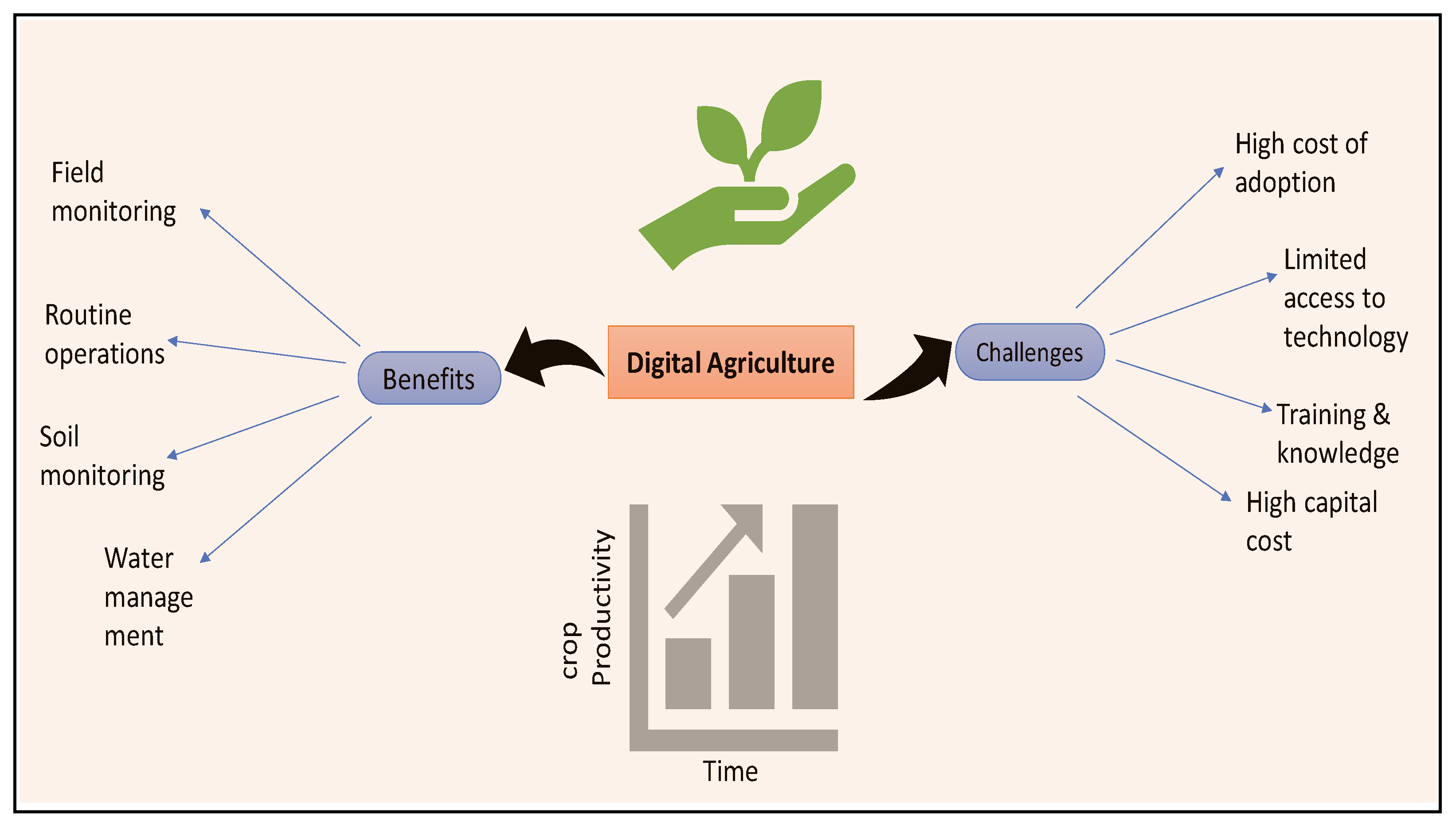
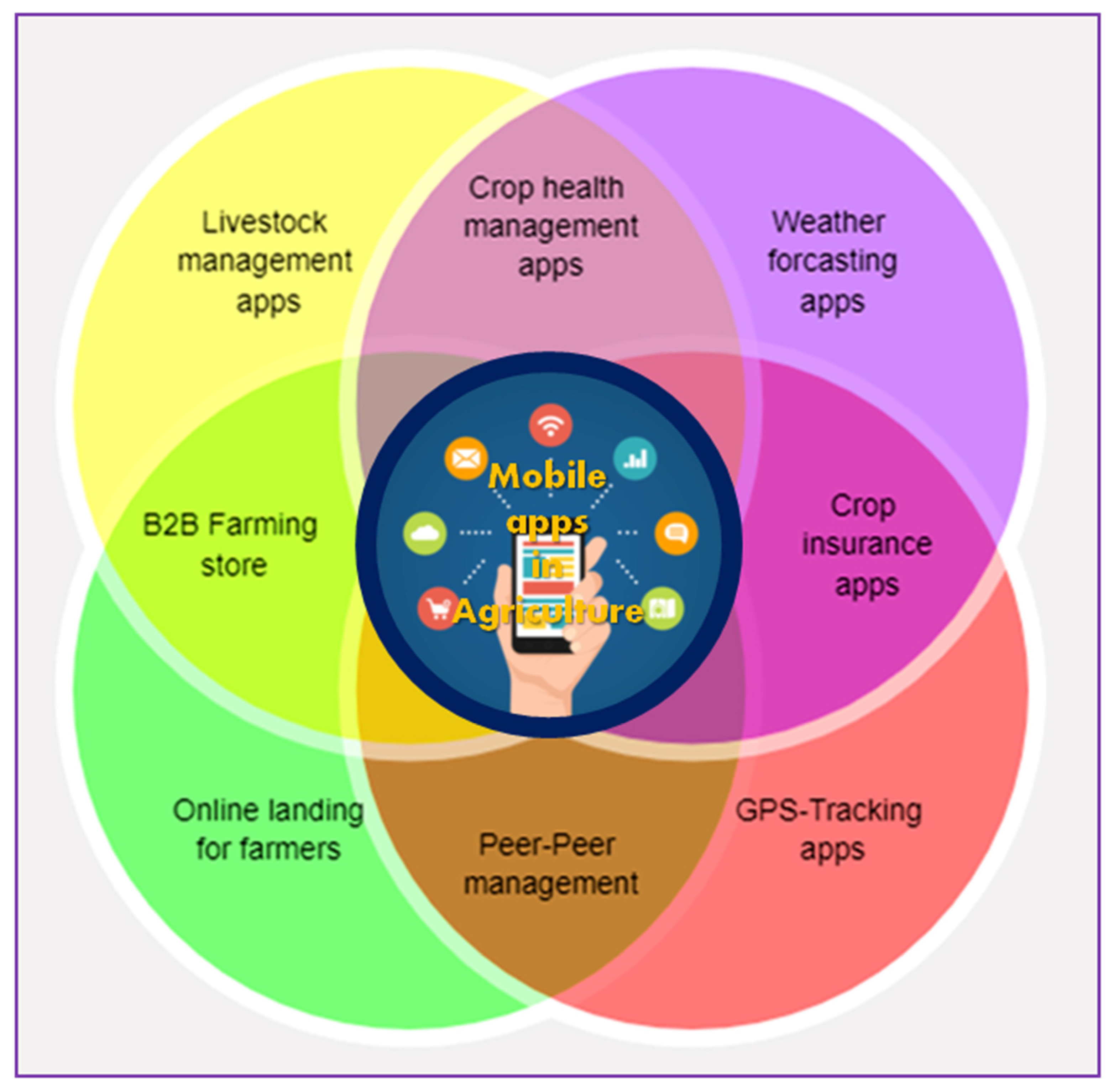
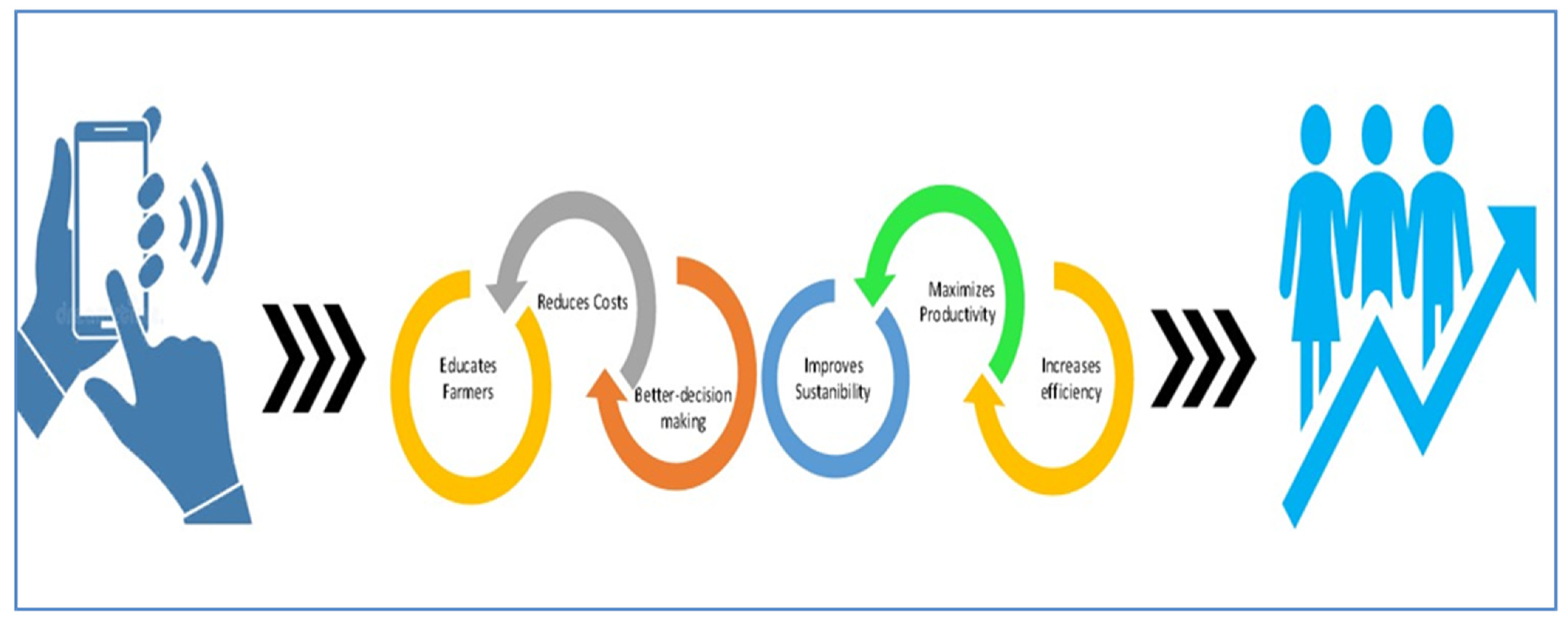
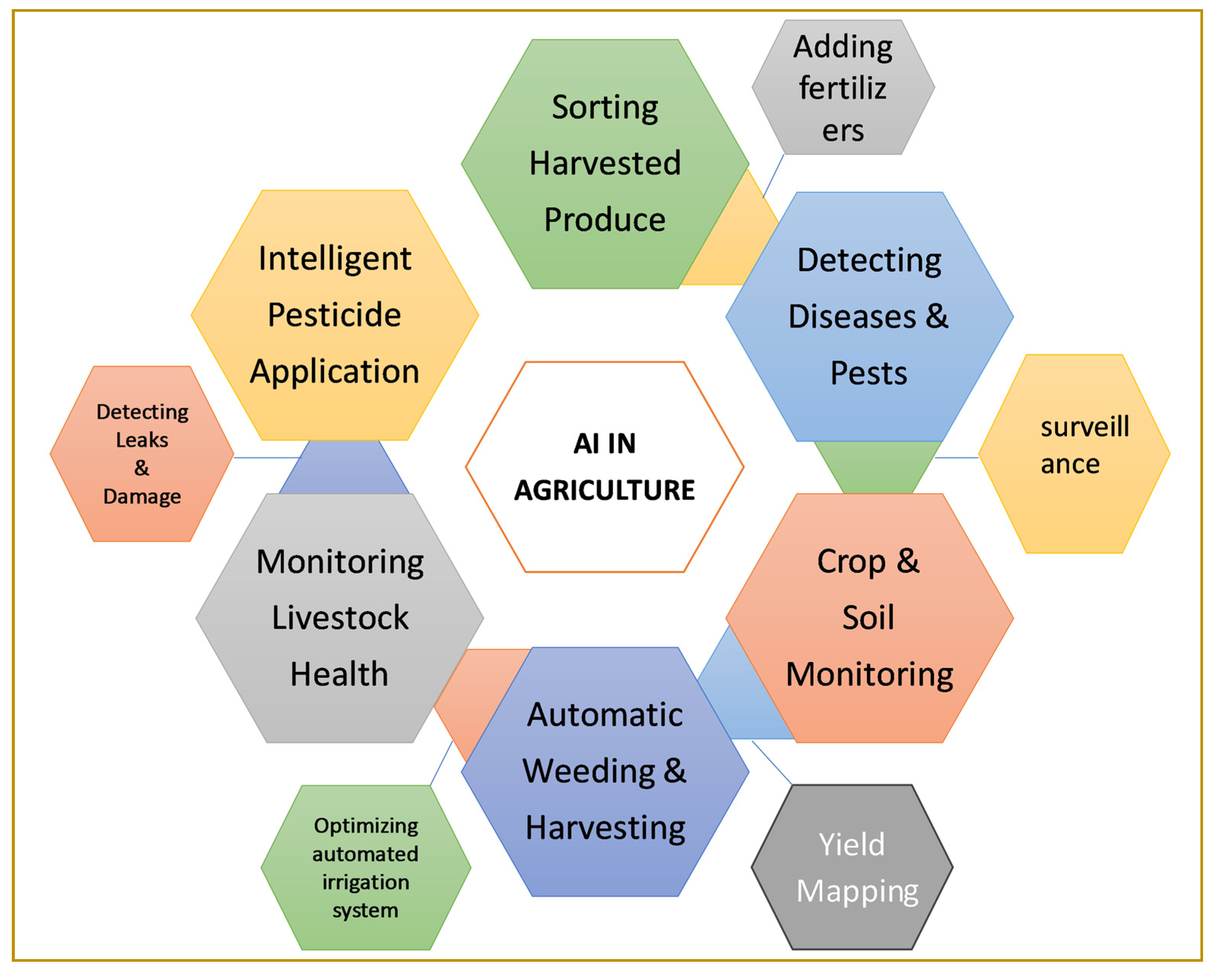
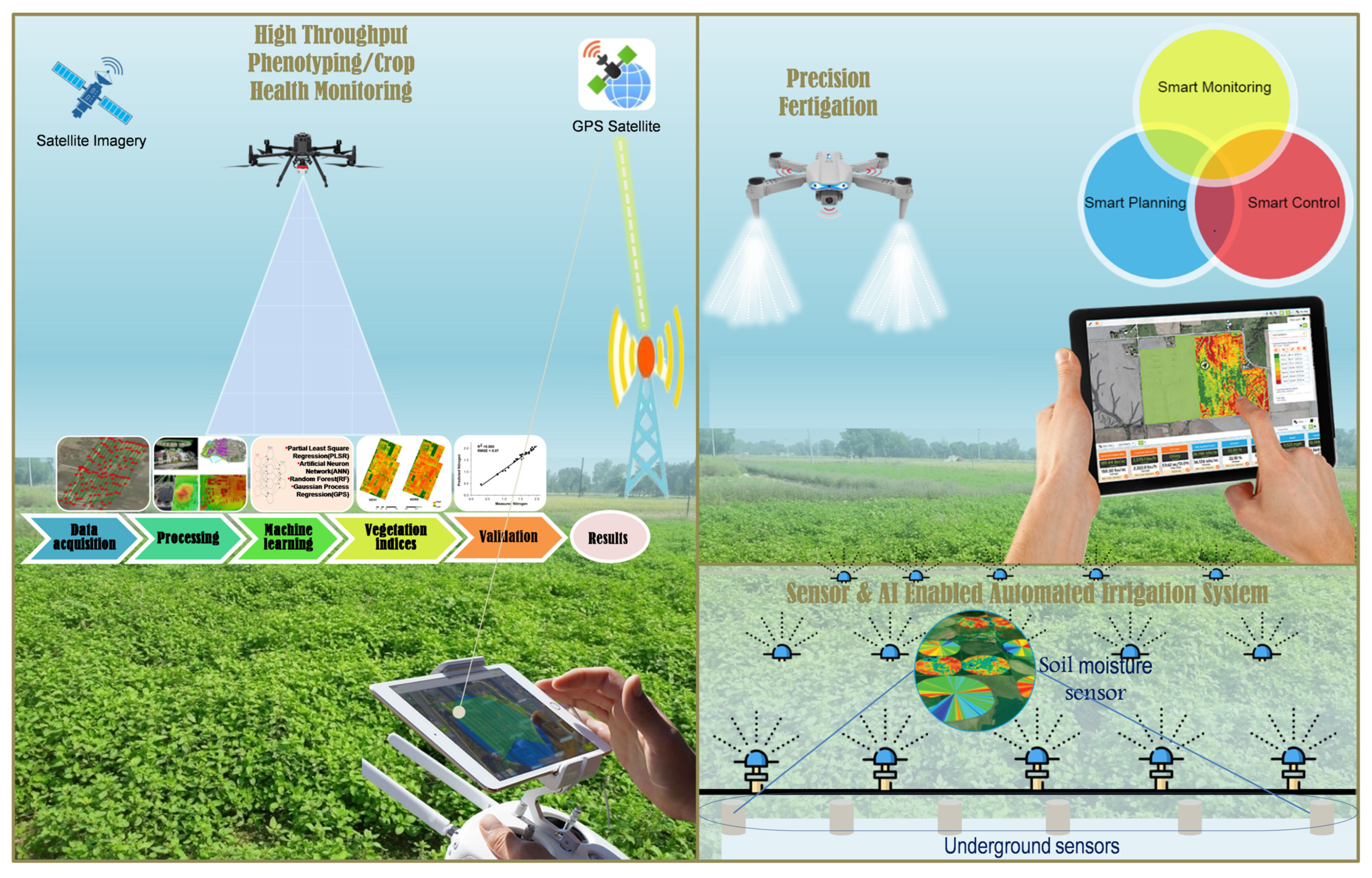
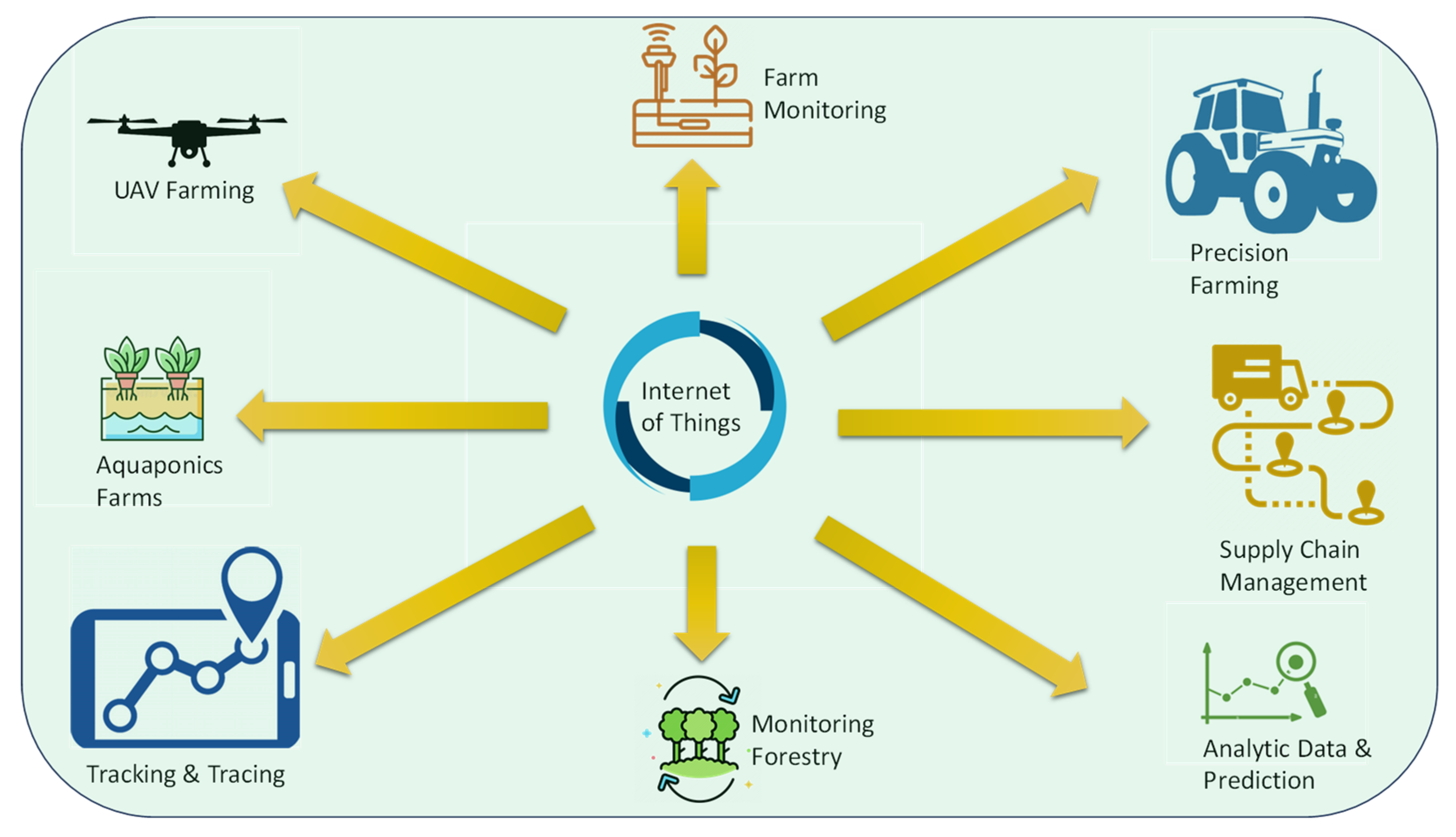
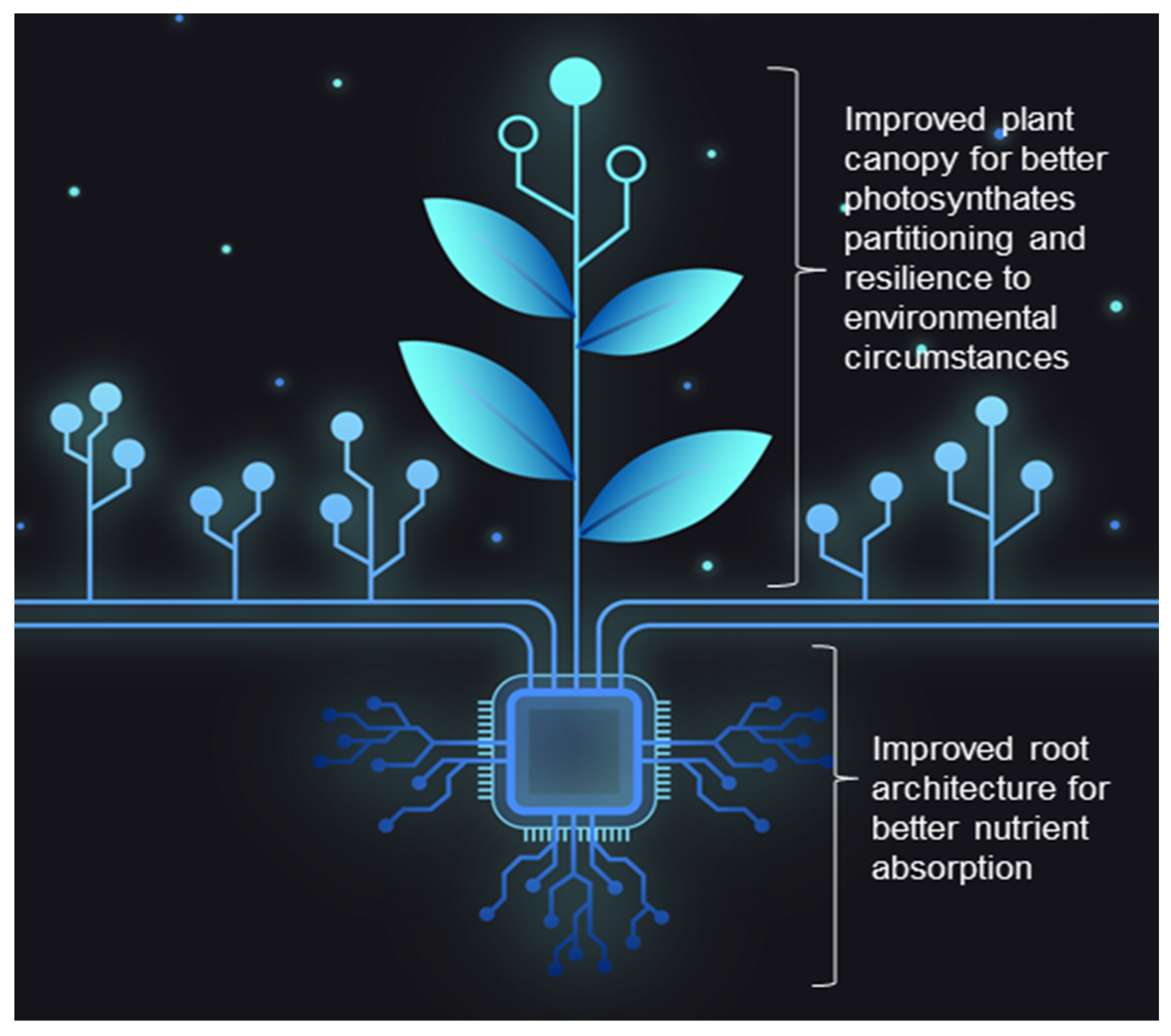
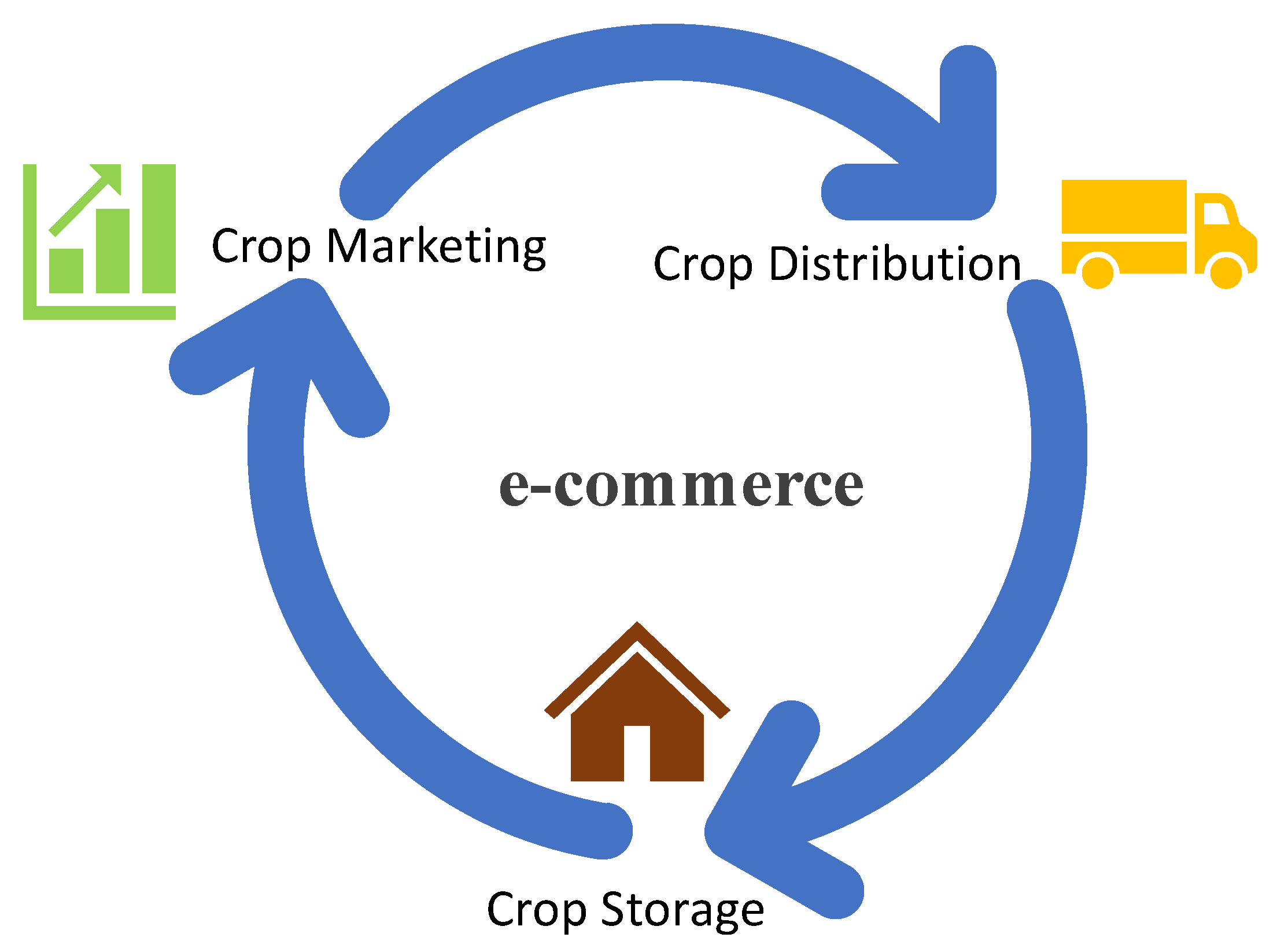
Disclaimer/Publisher’s Note: The statements, opinions and data contained in all publications are solely those of the individual author(s) and contributor(s) and not of MDPI and/or the editor(s). MDPI and/or the editor(s) disclaim responsibility for any injury to people or property resulting from any ideas, methods, instructions or products referred to in the content. |
© 2024 by the authors. Licensee MDPI, Basel, Switzerland. This article is an open access article distributed under the terms and conditions of the Creative Commons Attribution (CC BY) license (https://creativecommons.org/licenses/by/4.0/).
Share and Cite
Balyan, S.; Jangir, H.; Tripathi, S.N.; Tripathi, A.; Jhang, T.; Pandey, P. Seeding a Sustainable Future: Navigating the Digital Horizon of Smart Agriculture. Sustainability 2024, 16, 475. https://doi.org/10.3390/su16020475
Balyan S, Jangir H, Tripathi SN, Tripathi A, Jhang T, Pandey P. Seeding a Sustainable Future: Navigating the Digital Horizon of Smart Agriculture. Sustainability. 2024; 16(2):475. https://doi.org/10.3390/su16020475
Chicago/Turabian StyleBalyan, Sakshi, Harsita Jangir, Shakti Nath Tripathi, Arpita Tripathi, Tripta Jhang, and Praveen Pandey. 2024. "Seeding a Sustainable Future: Navigating the Digital Horizon of Smart Agriculture" Sustainability 16, no. 2: 475. https://doi.org/10.3390/su16020475
APA StyleBalyan, S., Jangir, H., Tripathi, S. N., Tripathi, A., Jhang, T., & Pandey, P. (2024). Seeding a Sustainable Future: Navigating the Digital Horizon of Smart Agriculture. Sustainability, 16(2), 475. https://doi.org/10.3390/su16020475










